20th-Century World Built Heritage Facing Water: Conservation of Fallingwater and Boa Nova Tea House
Abstract
1. Introduction
- The uniqueness of the work and its author—exploring the idea, form, and concept through architectural analysis;
- The definition and characterization of construction—including construction techniques, detailing, and materials;
- The challenges posed by water and exposure to extreme conditions—addressing conservation and maintenance efforts.
2. Conservation of Two Modern Buildings Facing Water
2.1. The Fallingwater
2.2. The Boa Nova Tea House
3. Technological Innovation and Constructive Characterization
3.1. Fallingwater
3.2. The Boa Nova Tea House
4. Conceptual Linkage
4.1. Attributes and Features in Both Sites and Buildings
- (a)
- Form and design: use and function
- (b)
- Materials and substance: traditions, techniques, and management systems
- (c)
- Location and setting: spirit, feeling, and other internal and external factors
4.2. Conservation Works and Plans Developed in Both Sites and Buildings
5. The Challenges of 20th-Century Built Heritage Facing Water
5.1. Materials Degradation
5.2. Monitoring and Maintenance
6. Final Remarks
Author Contributions
Funding
Data Availability Statement
Acknowledgments
Conflicts of Interest
References
- UNESCO World Heritage Centre. Identification and Documentation of Modern Heritage; World Heritage Papers No. 5; UNESCO: Paris, France, 2003. [Google Scholar]
- ICOMOS. Approaches for the Conservation of Twentieth-Century Architectural Heritage: Madrid-New Delhi Document; ICOMOS: Paris, France, 2017. [Google Scholar]
- ICOMOS. The Cádiz Document: InnovaConcrete Guidelines for the Conservation of Concrete Heritage; ICOMOS International: Paris, France, 2021. [Google Scholar]
- Wright, F.L. Architect, Balthazar Korab Studios, Ltd., Photographer; Fallingwater, Mill Run, Pennsylvania. Exterior. Pennsylvania, None. [Between 1955 and 2007] Photograph. Available online: https://www.loc.gov/item/2020714524/ (accessed on 8 May 2024).
- Morgado, J. Boa Nova Tea House Renovation. Available online: https://www.joaomorgado.com/eng/projects/boa-nova-tea-house-renovation (accessed on 8 May 2024).
- Jokilehto, J. A History of Architectural Conservation, 2nd ed.; Routledge: London, UK, 2018. [Google Scholar] [CrossRef]
- Wright, F.L. Project 3602: Edgar J. and Liliane Kaufmann house (Mill Run, Pennsylvania), Fallingwater, View from below. Repository: Avery Architectural & Fine Arts Library, Columbia University Avery Drawings & Archives Frank Lloyd Wright Foundation Archives: Architectural drawings, 1885–1959 Series VI: 1930s, New York. Available online: https://www.jstor.org/stable/community.36562339 (accessed on 8 May 2024).
- Zevi, B. Frank Lloyd Wright a cura di Bruno Zevi; Serie di Archittetura/4; Zanichelli: Bologna, Italy, 1979. [Google Scholar]
- Frampton, K.; Portas, N.; Castán, S. Profissão Poética; Gustavo Gili: Barcelona, Spain, 1981. [Google Scholar]
- Benevolo, L. Historia de la Arquitectura Moderna, 1st ed.; Taurus Ediciones: Madrid, Spain, 1963. [Google Scholar]
- Historic American Buildings Survey. Creator: Frank Lloyd Wright, Edgar J Kaufmann, Liliane S Kaufmann, Jacques Lipchitz, College of Architecture and Environmental Design Kent State University, Elizabeth Corbin Murphy; et al., Boucher, Jack E, photographer. Fallingwater, State Route 381 Stewart Township, Ohiopyle, Fayette County, PA. Ohiopyle Fayette County Pennsylvania, 1933. Documentation Compiled after. Photograph. Available online: https://www.loc.gov/item/pa1690/ (accessed on 8 May 2024).
- Wright, F.L. Project 3602: Edgar J. and Liliane Kaufmann house (Mill Run, Pennsylvania), Fallingwater, Working drawings. Repository: Avery Architectural & Fine Arts Library, Columbia University Avery Drawings & Archives Frank Lloyd Wright Foundation Archives: Architectural drawings, 1885–1959 Series VI: 1930s, New York. Available online: https://www.jstor.org/stable/community.36562399 (accessed on 8 May 2024).
- El Croquis, N. 68/69 Álvaro Siza 1958 1994; El Croquis Editorial: Madrid, Spain, 1994. [Google Scholar]
- Siza, Á. Imaginar a evidência; Edições 70: Lisbon, Portugal, 1998. [Google Scholar]
- Testa, P. Álvaro Siza; Martins Fontes: São Paulo, Brazil, 1998. [Google Scholar]
- Okakura, K. O livro do chá; Edições Cotovia: Lisbon, Portugal, 2009. [Google Scholar]
- Gomes, P.V. Casa de Chá da Boa Nova, 1991. In Casa de Chá da Boa Nova; Álvaro Siza Vieira 1958–1963; Blau: Lisbon, Portugal, 1992. [Google Scholar]
- Jodidio, P. Álvaro Siza; Taschen: Köln, Germany, 2003. [Google Scholar]
- Gregotti, V. Architecture recenti di Álvaro Siza. Controspazio 1972, 9. In Profissão Poética; Frampton, K., Portas, N., Castán, S., Eds.; Gustavo Gili: Barcelona, Sapin, 1988; p. 187. [Google Scholar]
- Figueira, J. O restauro da Casa de Chá. Revista Patrimonio 2017–18. 2018. Available online: https://hdl.handle.net/10316/101510 (accessed on 8 May 2024).
- Siza, A. Studies, Details, Elevations, and Plans, Casa de Chá, Restaurante da Boa Nova, Leça da Palmeira, Álvaro Siza Fonds, Collection Centre Canadien d’Architecture/Canadian Centre for Architecture, Montréal. Available online: https://www.cca.qc.ca/en/archives/447183/alvaro-siza-fonds/469692/architectural-projects/473701/casa-de-cha-restaurante-da-boa-nova-tea-house-boa-nova-restaurant-leca-da-palmeira-portugal-1958-1959-1963. (accessed on 8 May 2024).
- Álvaro Siza Fonds. Tea House Plan; Stamped and Approved by Tourism Secretary, Municipal Archives Matosinhos, Portugal, 1959. Available online: https://bmfe.cm-matosinhos.pt/ipac20/ipac.jsp?profile=. (accessed on 8 May 2024).
- Silman, R. The Plan to Save Fallingwater. In Scientific American; Nature Publishing Group: New York, NY, USA, 2000; Volume 283, pp. 88–95. [Google Scholar]
- Norman, W.; Jerome, P.; Gottlieb, S. Fallingwater: Materials-Conservation Efforts at Frank Lloyd Wright’s Masterpiece (Part 1). Assoc. Preserv. Technol. Bull. 2001, 32, 44–55. [Google Scholar]
- Ferreira, T.; Barbosa, F.; Fernandes, E. Construction culture between tradition and modernity: Three works by Álvaro Siza. In History of Construction Cultures, 1st ed.; Mascarenhas-Mateus, J., Paula Pires, A., Eds.; CRC Press: Boca Raton, FL, USA, 2021; pp. 594–601. [Google Scholar] [CrossRef]
- Ferreira, T.C.; Fernandes, E. Alvaro Siza’s Tectonic Shift in Leça da Palmeira: From Design to Conservation. In Proceedings of the 16th International Docomomo Conference Tokyo Japan 2020+1. Inheritable Resilience: Sharing Values of Global Modernities. Docomomo 2021, Tokyo, Japan, 10–14 September 2021. [Google Scholar]
- Weisberg, R. Frank Lloyd Wright’s Fallingwater: A Case Study in Inside-the-Box Creativity. Creat. Res. J. 2011, 23, 296–312. [Google Scholar] [CrossRef]
- Toker, F. Fallingwater rising: Frank Lloyd Wright, E.J. In Kaufmann, and America’s Most Extraordinary House; Knopf: New York, NY, USA, 2003. [Google Scholar]
- Norberg-Schulz, C. Genius Loci: Towards a Phenomenology of Architecture; Rizzoli: New York, NY, USA, 1980. [Google Scholar]
- Weconservepa. WPC Adds Land to Bear Run Reserve. 2024. Available online: https://weconservepa.org/blog/wpc-adds-land-to-bear-run-reserve/ (accessed on 2 May 2024).
- Matteo, J. Fallingwater—Structural intervention, in time. In Structural Analysis of Historical Constructions; Modena, C., Lourenço, P.B., Roca, P., Eds.; Taylor & Francis Group: Abingdon, UK, 2005. [Google Scholar]
- Jerome, P.; Emilio, D. Digital Documentation of Frank Lloyd Wright’s Masterpiece, Fallingwater. Int. Arch. Photogramm. Remote Sens. Spat. Inf. Sci. 2017, XLII-2/W5, 389–393. [Google Scholar] [CrossRef]
- Stubbs, J. Time Honored: A Global View of Architectural Conservation; John Wiley & Sons: Hoboken, NJ, USA, 2009. [Google Scholar]
- Orbasli, A. Architectural Conservation: Principles and Practice; Blackwell Science: Oxford, UK, 2008. [Google Scholar]
- Fallingwater. Fallingwater Archive, 1994.22, Courtesy of the Western Pennsylvania Conservancy. Available online: https://waterlandlife.org/entrusted-wpc-1963/ (accessed on 8 May 2024).
- Macdonald, S. 20th-Century Heritage: Recognition, Protection and Practical Challenges. In Heritage at Risk 2002/2003; Jaeger, R., Ed.; ICOMOS: Paris, France, 2003; pp. 223–229. [Google Scholar]
- Ziegler, V.; Reicher, C.; Greiving, S.; Neugebauer, C.; Klanten, C. Resilience and Cultural Heritage in Urban Development: From Holistic Guidelines to Practical Approaches. Blue Pap. 2024, 3, 1. [Google Scholar] [CrossRef]
- Qu, F.; Li, W.; Dong, W.; Tam, V.W.Y.; Yu, T. Durability deterioration of concrete under marine environment from material to structure: A critical review. J. Build. Eng. 2021, 35, 102074. [Google Scholar] [CrossRef]
- Pratiwi, W.D.; Putra, lF.D.D.; Triwulan; Tajunnisa, Y.; Husin, N.A.; Wulandari, K.D. A review of concrete durability in marine environment. IOP Conf. Ser. Mater. Sci. Eng. 2021, 1175, 012018. [Google Scholar] [CrossRef]
- Macdonald, S.; Gonçalves, A.P. Conservation Principles for Concrete of Cultural Significance; Getty Conservation Institute: Los Angeles, CA, USA, 2020. [Google Scholar]
- Papadakis, V.; Vayenas, C.; Fardis, M. Physical and Chemical Characteristics Affecting the Durability of Concrete. Mater. J. 1991, 88, 186–196. [Google Scholar]
- Zhang, S.P.; Zong, L. Evaluation of Relationship between Water Absorption and Durability of Concrete Materials. Adv. Mater. Sci. Eng. 2014, 2014, 650373. [Google Scholar] [CrossRef]
- Wang, Y.; Li, L.; An, M.; Sun, Y.; Yu, Z.; Huang, H. Factors Influencing the Capillary Water Absorption Characteristics of Concrete and Their Relationship to Pore Structure. Appl. Sci. 2022, 12, 2211. [Google Scholar] [CrossRef]
- Harrison, T.A. Concrete Degradation: Addressing the real causes. In Controlling Concrete Degradation. Proceedings of the International Seminar, University of Dundee, UK; Dhir, R.K., Newlands, M.D., Eds.; Thomas Telford Publishing: London, UK, 1999. [Google Scholar]
- Macdonald, S. Conserving concrete. In Conservation Perspectives, The CGI Newsletter 34; Getty Conservation Institute: Los Angeles, CA, USA, 2019. [Google Scholar]
- UNESCO. Operational Guidelines. 2023. Available online: https://whc.unesco.org/archive/opguide12-en.pdf (accessed on 2 May 2024).
- Australia ICOMOS. The Burra Charter (The Australia ICOMOS Charter for Places of Cultural Significance); Australia ICOMOS Inc.: Canberra, Australia, 1999. [Google Scholar]
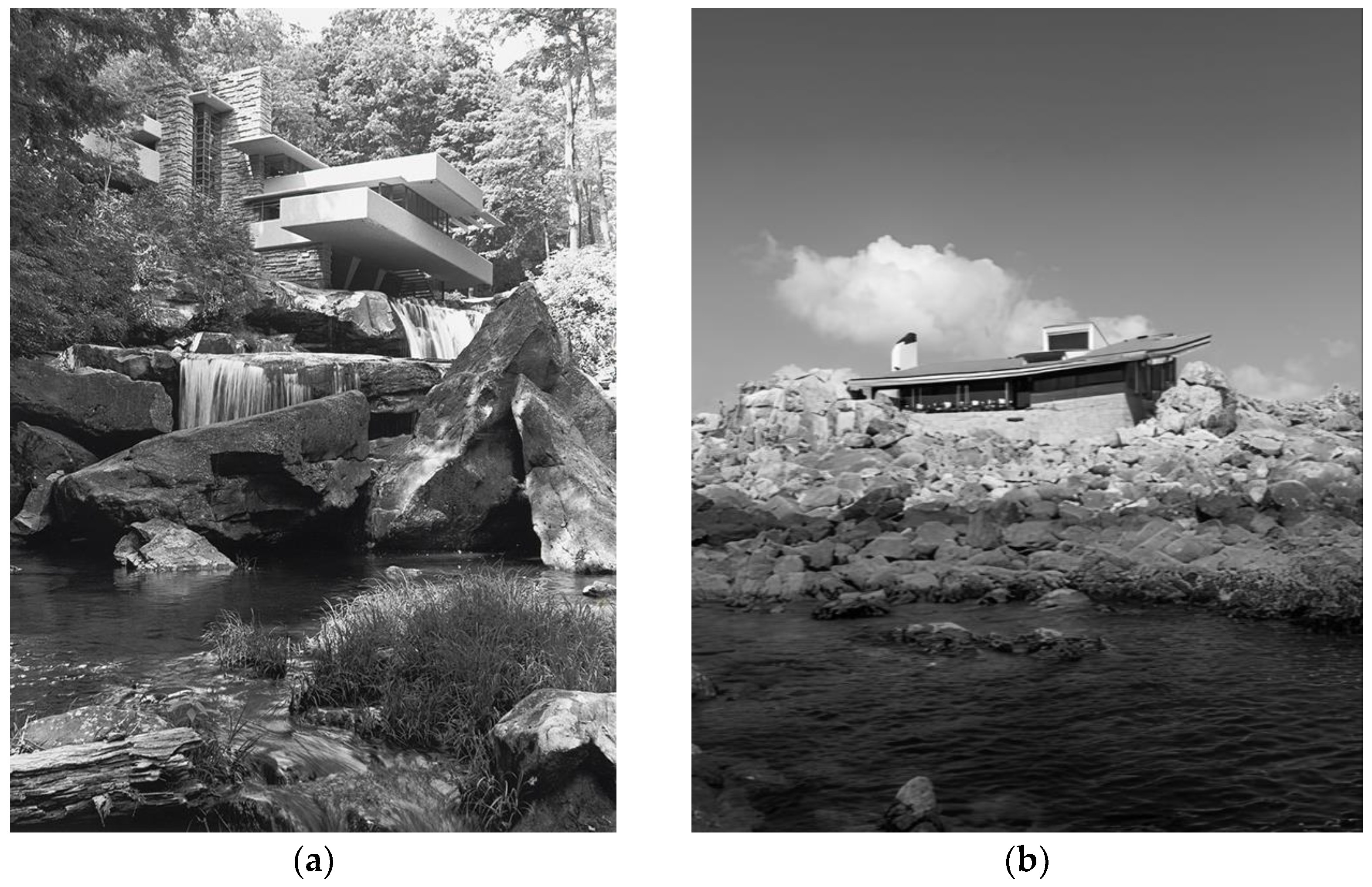
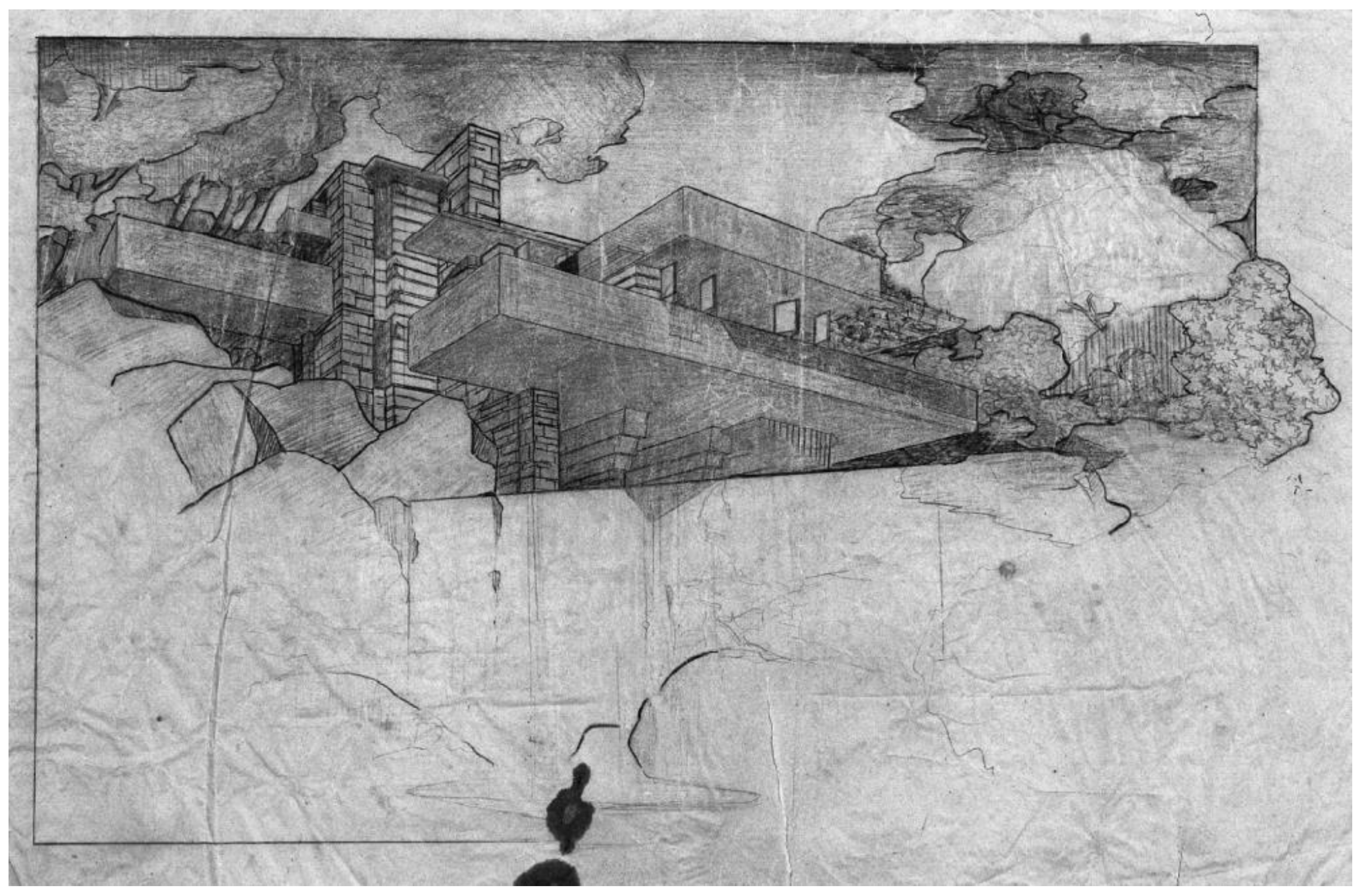
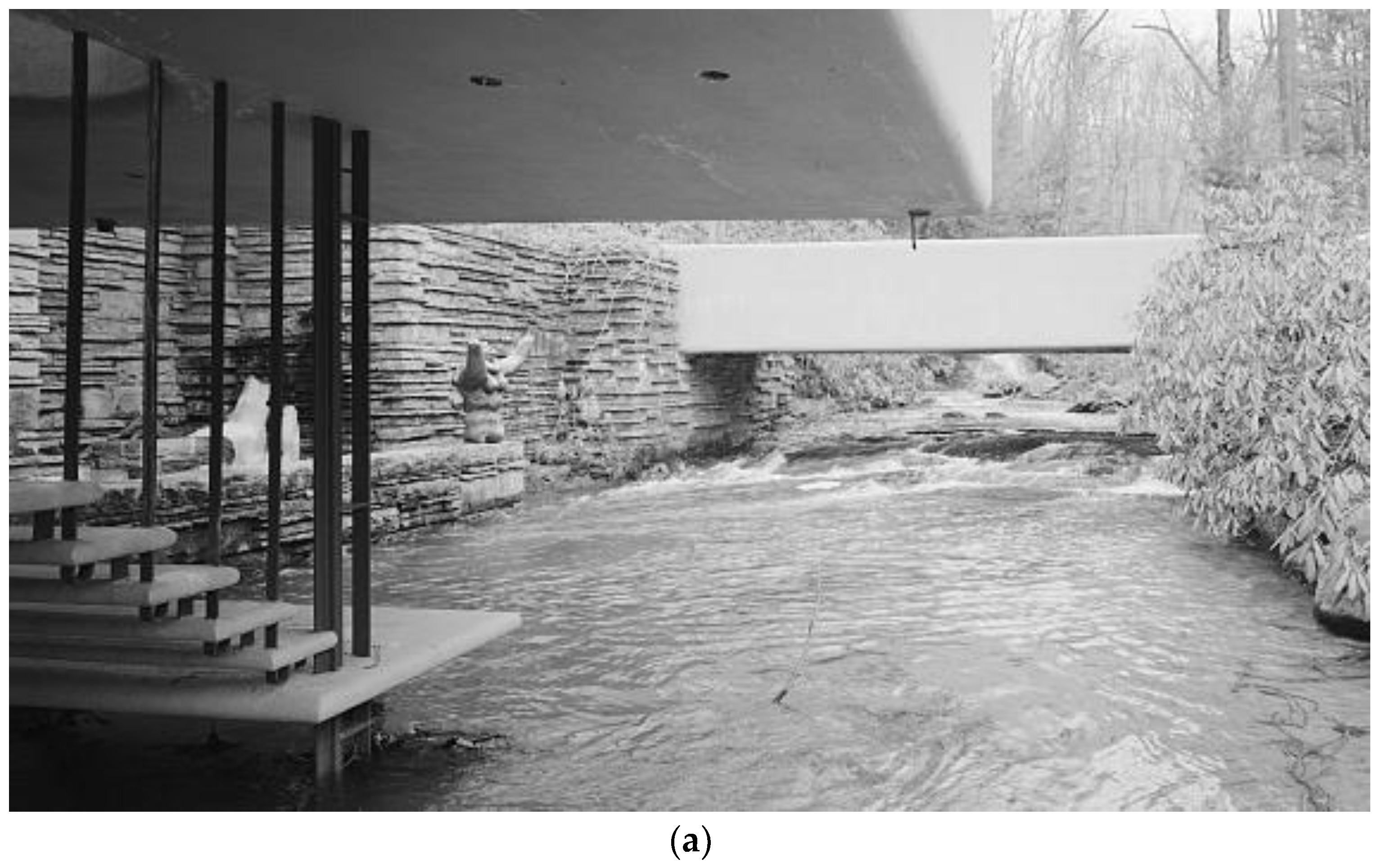
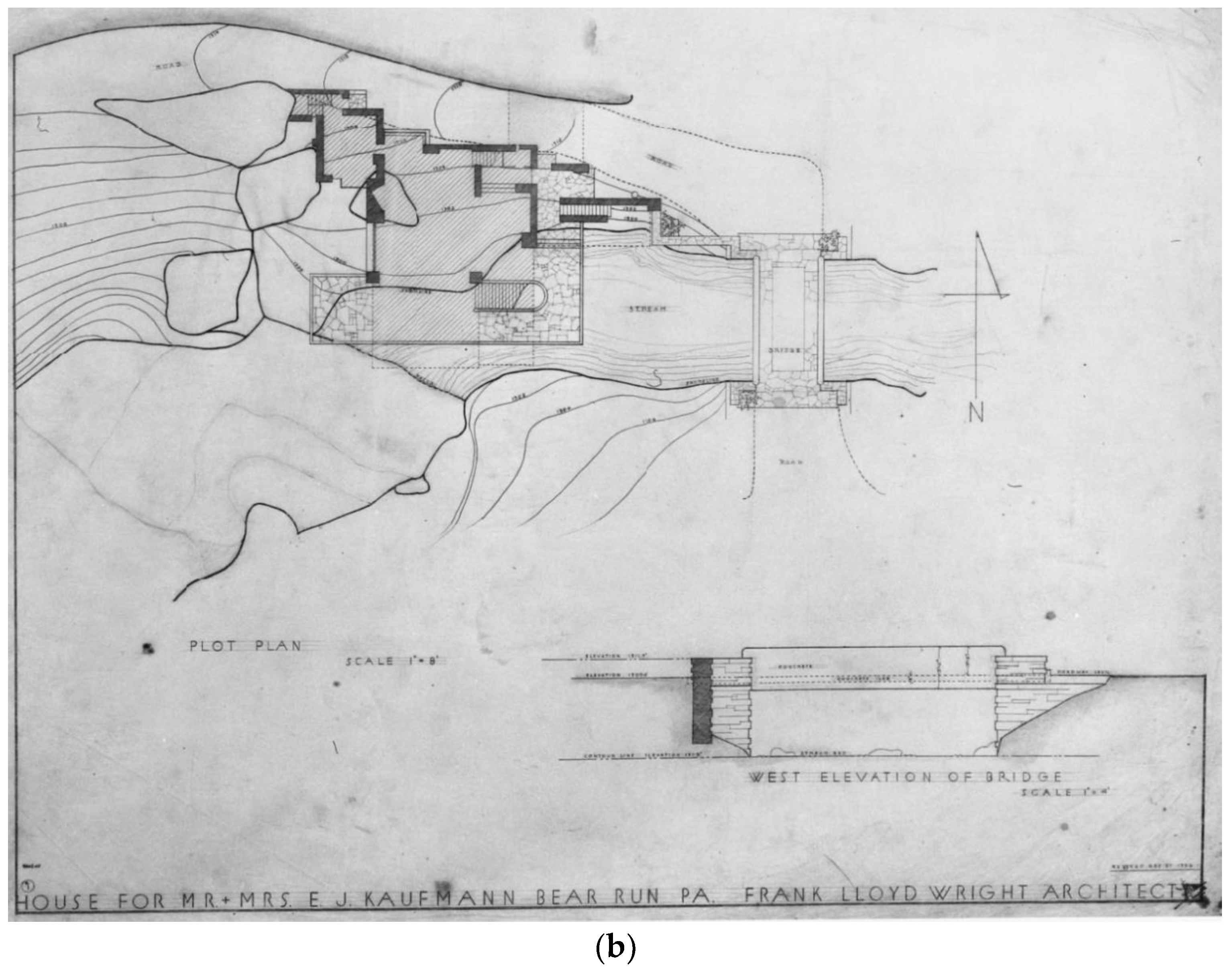
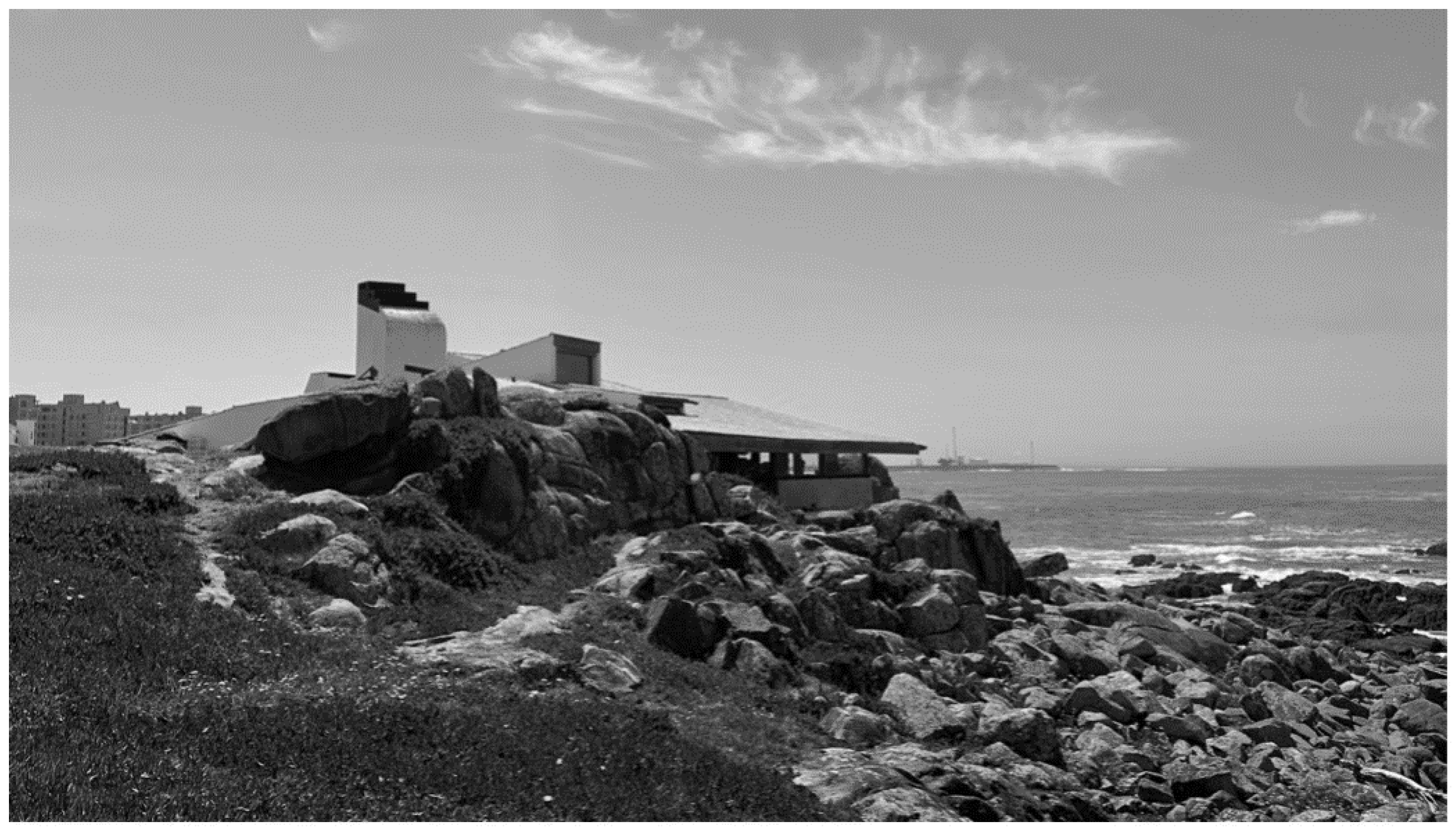

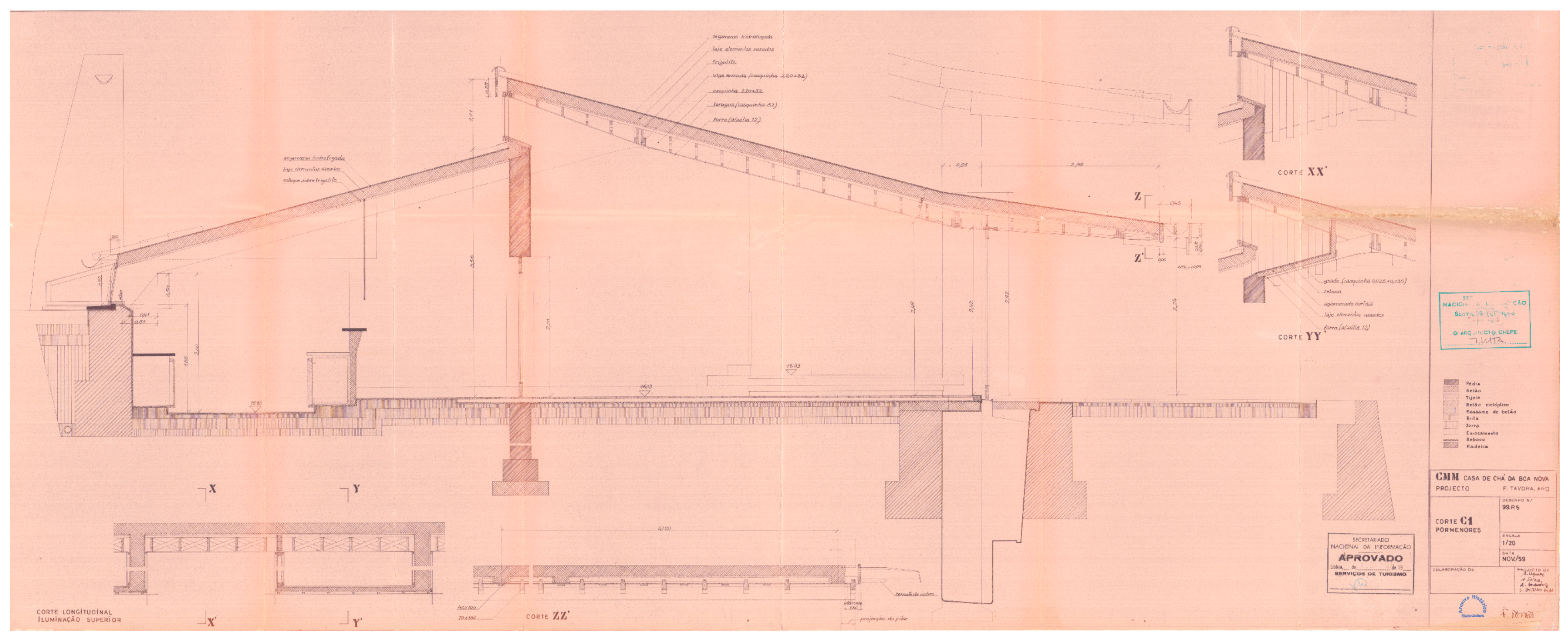
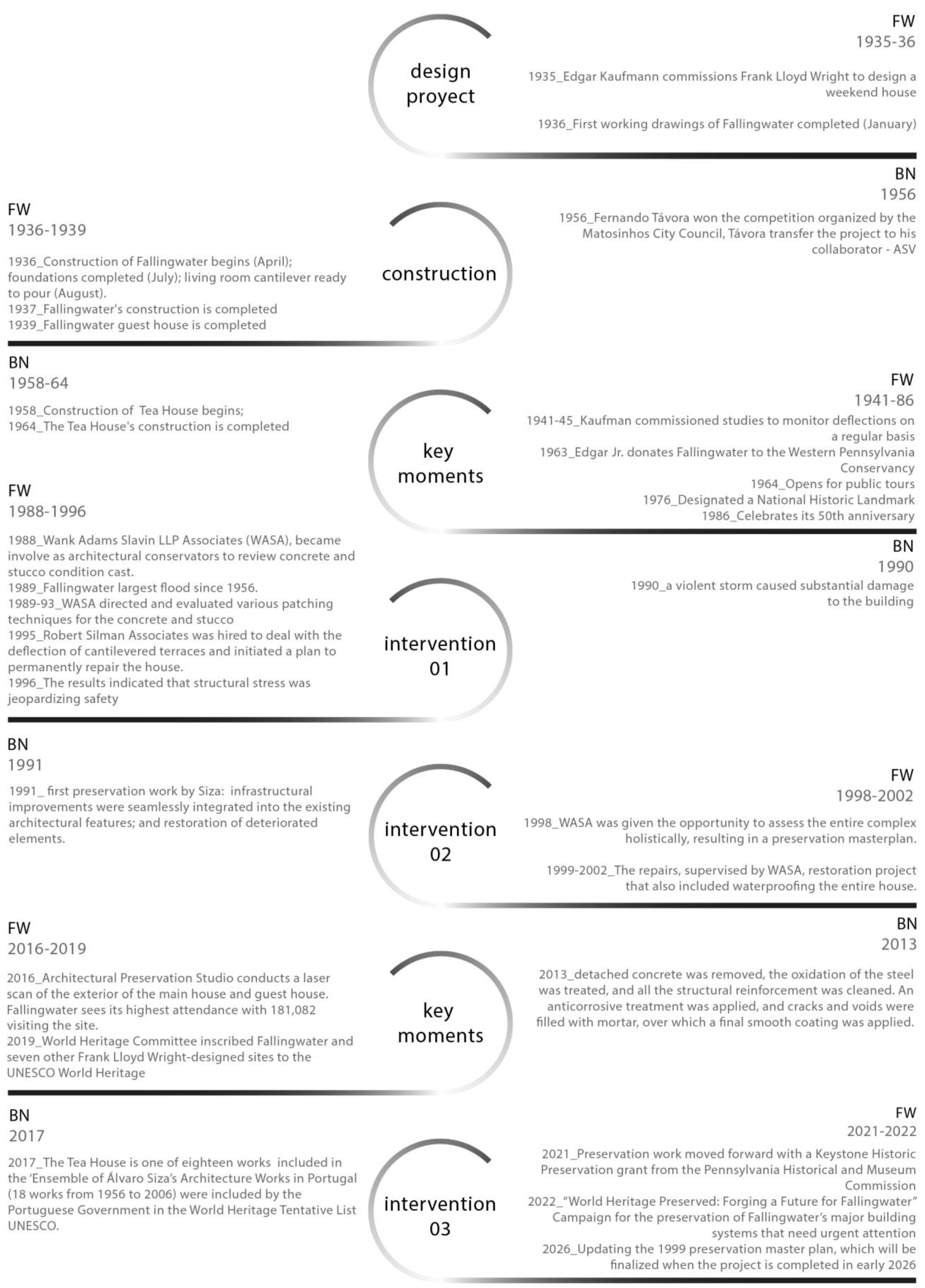
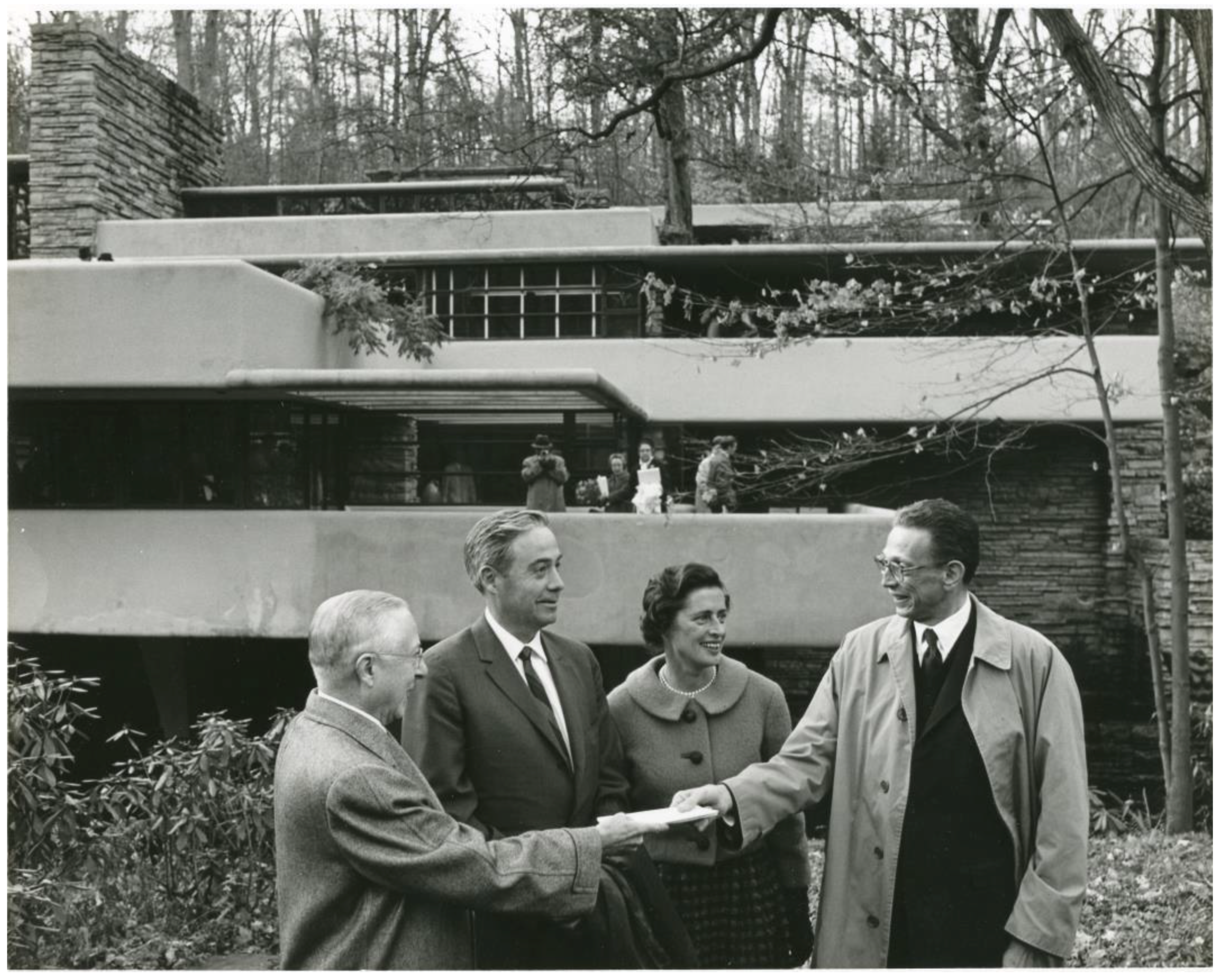
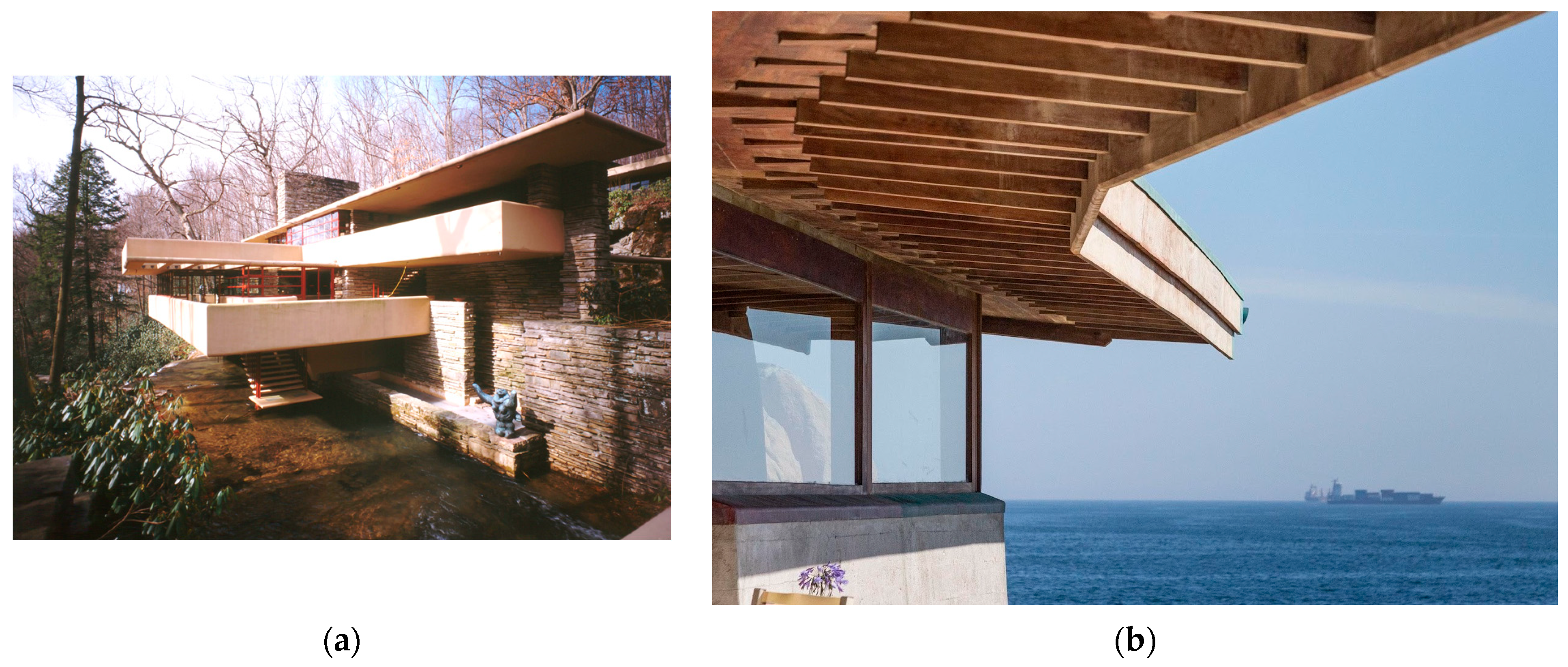
| FALLINGWATER/KAUFMAN HOUSE | BOA NOVA TEAHOUSE |
|---|---|
| Form and design; use and function: Main house (holiday) and Guest House, including bridge across the stream. Cantilevered house over a stream/waterfall; Extended upper balcony. Cultural Tourism—WPC | Form and design; use and function; Construction on the geological structure of the rocks. Incline roofs; Rectangular plan, irregularly shaped, resting on a reinforced concrete platform. Tea house, restaurant, Cultural Tourism. |
| Materials and substance; traditions, techniques and management systems: Support pillars on geological rock structure. Beams supported by the rocky escarpment. Walls and floors in local stone masonry. Steel-reinforced concrete balconies with internal grid structure. Flat roof and cantilevered balconies. Structural stone masonry walls. Combining traditional techniques (Stone walls) with innovative construction technologies (concrete). | Materials and substance; traditions, techniques and management systems: Sloping roof with pillar and beam structure and reinforced concrete slab. Tiled roofs with prominent cantilevered eaves. Long, horizontal windows with a recess in the floor (west elevation). Sloping ceilings clad in wood and copper sheeting. White chimneys (formal elements) finished with simple eaves. Combining traditional techniques (wood and concrete). |
| Location and setting; spirit and feeling; and other internal and external factors: Location on the north bank above the waterfalls. Access path through the park and forest, crossing a bridge as part of the Japanese tradition of approach. A response to the Kaufmanns’ desire to live in the park near the waterfall Small area of flat open land on the north bank. Close contact with the water, intimate experience, accessed by stairs from the inside. Natural Park and reserve. | Location and setting; spirit and feeling; and other internal and external factors: Location on the Atlantic coastline. Access path (promenade architecturel) between a view of the sea and the rocks that surround the building; Approach ritual, Japanese tradition. Construction integrated into the rocks with reduced visual impact; Slope exploited to accentuate interior views of the sea. Religious and symbolic place, small church nearby. Protect coastline. |
Disclaimer/Publisher’s Note: The statements, opinions and data contained in all publications are solely those of the individual author(s) and contributor(s) and not of MDPI and/or the editor(s). MDPI and/or the editor(s) disclaim responsibility for any injury to people or property resulting from any ideas, methods, instructions or products referred to in the content. |
© 2024 by the authors. Licensee MDPI, Basel, Switzerland. This article is an open access article distributed under the terms and conditions of the Creative Commons Attribution (CC BY) license (https://creativecommons.org/licenses/by/4.0/).
Share and Cite
Milão, S.; Ribeiro, T.; Neves, I.C.; Lima, A.; Pacheco, L.P. 20th-Century World Built Heritage Facing Water: Conservation of Fallingwater and Boa Nova Tea House. Buildings 2024, 14, 3004. https://doi.org/10.3390/buildings14093004
Milão S, Ribeiro T, Neves IC, Lima A, Pacheco LP. 20th-Century World Built Heritage Facing Water: Conservation of Fallingwater and Boa Nova Tea House. Buildings. 2024; 14(9):3004. https://doi.org/10.3390/buildings14093004
Chicago/Turabian StyleMilão, Susana, Telma Ribeiro, Isabel Clara Neves, Ana Lima, and Luís Paulo Pacheco. 2024. "20th-Century World Built Heritage Facing Water: Conservation of Fallingwater and Boa Nova Tea House" Buildings 14, no. 9: 3004. https://doi.org/10.3390/buildings14093004
APA StyleMilão, S., Ribeiro, T., Neves, I. C., Lima, A., & Pacheco, L. P. (2024). 20th-Century World Built Heritage Facing Water: Conservation of Fallingwater and Boa Nova Tea House. Buildings, 14(9), 3004. https://doi.org/10.3390/buildings14093004








